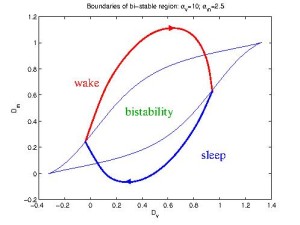 Gianne Derks visited the Mathematics Department at the University of Twente in the Netherlands on Friday 09 May. She gave a talk on “Mathematical analysis of human sleep-wake dynamics“, reporting on joint work with Anne Skeldon and Derk-Jan Dijk. An abstract follows. Human sleep-wake dynamics is often modelled by multi-oscillator systems. Recent research has shown that wake and sleep can, in part, be characterised by the firing states of different groups
Gianne Derks visited the Mathematics Department at the University of Twente in the Netherlands on Friday 09 May. She gave a talk on “Mathematical analysis of human sleep-wake dynamics“, reporting on joint work with Anne Skeldon and Derk-Jan Dijk. An abstract follows. Human sleep-wake dynamics is often modelled by multi-oscillator systems. Recent research has shown that wake and sleep can, in part, be characterised by the firing states of different groups
of neurones. Two important groups are the ventrolateral preoptic nucleus (VLPO), its neurons fire during sleep, and the monoaminergic (MA) group, which fire during wake. Models that couple these populations of neurones in a mutually inhibitory way and that model the circadian and homeostatic process as a drive that couples to the VLPO have been successful at describing sleep deprivation experiments and the impact of stimulants. In her talk, a general class of such models was considered, focusing on the roles played by drives on the VLPO and MA in the system and the interplay between these drives and the sleep-wake cycle. Various aspects were discussed such as the intrinsic period and robustness to modelling assumptions on the drives. With no circadian drive present, the relation between the model parameters, the intrinsic period, and time spent asleep can be derived. When the circadian drive acts on the system, a two dimensional system for the homeostatic and circadian drives characterises the sleep-wake cycle. It will be shown that the sleep-wake cycle persists if the circadian drive acts on the MA or MA and VLPO, instead of the VLPO only.
